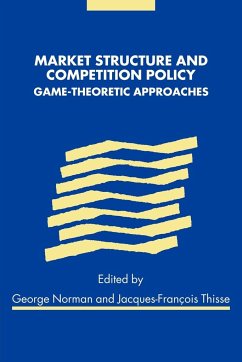Market Structure and Competition Policy
Game-Theoretic Approaches
Herausgeber: Norman, George; Thisse, Jacques-Francois
Market Structure and Competition Policy
Game-Theoretic Approaches
Herausgeber: Norman, George; Thisse, Jacques-Francois
- Broschiertes Buch
- Merkliste
- Auf die Merkliste
- Bewerten Bewerten
- Teilen
- Produkt teilen
- Produkterinnerung
- Produkterinnerung
This 2000 text applies modern advances in game theory to the analysis of competition policy.
This 2000 text applies modern advances in game theory to the analysis of competition policy.
Produktdetails
- Produktdetails
- Verlag: Cambridge University Press
- Seitenzahl: 306
- Erscheinungstermin: 16. Juni 2011
- Englisch
- Abmessung: 229mm x 152mm x 18mm
- Gewicht: 500g
- ISBN-13: 9781107403260
- ISBN-10: 110740326X
- Artikelnr.: 33875610
- Herstellerkennzeichnung
- Libri GmbH
- Europaallee 1
- 36244 Bad Hersfeld
- gpsr@libri.de
- Verlag: Cambridge University Press
- Seitenzahl: 306
- Erscheinungstermin: 16. Juni 2011
- Englisch
- Abmessung: 229mm x 152mm x 18mm
- Gewicht: 500g
- ISBN-13: 9781107403260
- ISBN-10: 110740326X
- Artikelnr.: 33875610
- Herstellerkennzeichnung
- Libri GmbH
- Europaallee 1
- 36244 Bad Hersfeld
- gpsr@libri.de
Introduction; 1. Competition policy and game theory: reflection based on
the cement industry case Claude d'Aspremont, David Encaoua and Jean-Pierre
Ponssard; 2. Legal standards and economic analysis of collusion in the EC
competition policy Damien J. Neven; 3. A guided tour of the folk theorem
James W. Friedman; 4. Predatory pricing and anti-dumping P. K. M. Tharakan;
5. Should pricing policies be regulated when firms may tacitly collude?
George Norman and Jacques-François Thisse; 6. Tougher price competition or
lower concentration: a trade-off for antitrust authorities? Claude
d'Aspremont and Massimo Motta; 7. The strategic effects of supply
guarantees: the raincheck game Jonathan H. Hamilton; 8. Product market
competition policy and technological performance Stephen Martin; 9. On some
issues in the theory of competition in regulated markets Gianni de Fraja;
10. Modelling the entry and exit process in dynamic competition: an
introduction to repeated commitment models Jean-Pierre Ponssard; 11.
Coordination failures in the Cournot approach to deregulated bank
competition André de Palma and Robert J. Gary-Bobo; 12. How the adoption of
a new technology is affected by the interaction between labor and product
markets Xavier Wauthy and Yves Zenou.
the cement industry case Claude d'Aspremont, David Encaoua and Jean-Pierre
Ponssard; 2. Legal standards and economic analysis of collusion in the EC
competition policy Damien J. Neven; 3. A guided tour of the folk theorem
James W. Friedman; 4. Predatory pricing and anti-dumping P. K. M. Tharakan;
5. Should pricing policies be regulated when firms may tacitly collude?
George Norman and Jacques-François Thisse; 6. Tougher price competition or
lower concentration: a trade-off for antitrust authorities? Claude
d'Aspremont and Massimo Motta; 7. The strategic effects of supply
guarantees: the raincheck game Jonathan H. Hamilton; 8. Product market
competition policy and technological performance Stephen Martin; 9. On some
issues in the theory of competition in regulated markets Gianni de Fraja;
10. Modelling the entry and exit process in dynamic competition: an
introduction to repeated commitment models Jean-Pierre Ponssard; 11.
Coordination failures in the Cournot approach to deregulated bank
competition André de Palma and Robert J. Gary-Bobo; 12. How the adoption of
a new technology is affected by the interaction between labor and product
markets Xavier Wauthy and Yves Zenou.
Introduction; 1. Competition policy and game theory: reflection based on
the cement industry case Claude d'Aspremont, David Encaoua and Jean-Pierre
Ponssard; 2. Legal standards and economic analysis of collusion in the EC
competition policy Damien J. Neven; 3. A guided tour of the folk theorem
James W. Friedman; 4. Predatory pricing and anti-dumping P. K. M. Tharakan;
5. Should pricing policies be regulated when firms may tacitly collude?
George Norman and Jacques-François Thisse; 6. Tougher price competition or
lower concentration: a trade-off for antitrust authorities? Claude
d'Aspremont and Massimo Motta; 7. The strategic effects of supply
guarantees: the raincheck game Jonathan H. Hamilton; 8. Product market
competition policy and technological performance Stephen Martin; 9. On some
issues in the theory of competition in regulated markets Gianni de Fraja;
10. Modelling the entry and exit process in dynamic competition: an
introduction to repeated commitment models Jean-Pierre Ponssard; 11.
Coordination failures in the Cournot approach to deregulated bank
competition André de Palma and Robert J. Gary-Bobo; 12. How the adoption of
a new technology is affected by the interaction between labor and product
markets Xavier Wauthy and Yves Zenou.
the cement industry case Claude d'Aspremont, David Encaoua and Jean-Pierre
Ponssard; 2. Legal standards and economic analysis of collusion in the EC
competition policy Damien J. Neven; 3. A guided tour of the folk theorem
James W. Friedman; 4. Predatory pricing and anti-dumping P. K. M. Tharakan;
5. Should pricing policies be regulated when firms may tacitly collude?
George Norman and Jacques-François Thisse; 6. Tougher price competition or
lower concentration: a trade-off for antitrust authorities? Claude
d'Aspremont and Massimo Motta; 7. The strategic effects of supply
guarantees: the raincheck game Jonathan H. Hamilton; 8. Product market
competition policy and technological performance Stephen Martin; 9. On some
issues in the theory of competition in regulated markets Gianni de Fraja;
10. Modelling the entry and exit process in dynamic competition: an
introduction to repeated commitment models Jean-Pierre Ponssard; 11.
Coordination failures in the Cournot approach to deregulated bank
competition André de Palma and Robert J. Gary-Bobo; 12. How the adoption of
a new technology is affected by the interaction between labor and product
markets Xavier Wauthy and Yves Zenou.

